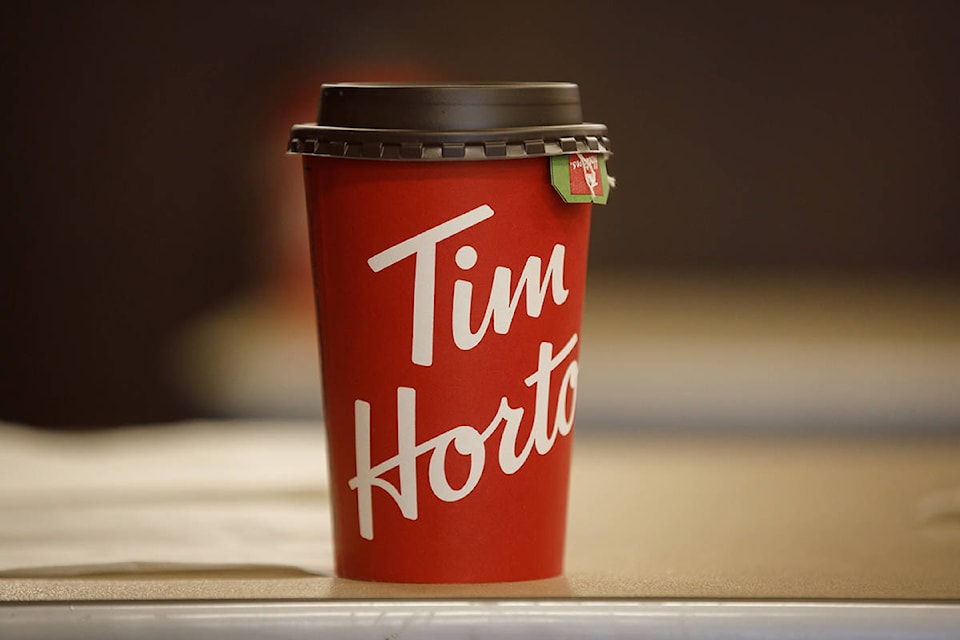As the COVID-19 pandemic started to spread, Tim Hortons reviewed its advertising plans and decided they no longer made sense as store closures, wide-scale layoffs and physical distancing upended life in Canada.
Instead, the coffee chain went back to the drawing board for two new ads. One informs customers how to buy doughnuts, double doubles and other products without going inside a restaurant, while the other follows Tim Hortons trucks delivering free coffee and doughnuts to essential workers.
“When we looked at what media we had committed to, we said: ‘There’s a better way,’” said Hope Bagozzi, chief marketing officer at Restaurant Brands International, the parent company for Tim Hortons.
Corporate spots acknowledging the pandemic have proliferated on TV breaks in recent weeks as companies grapple with how to fill previously purchased ad slots and what, if anything, they want to to say. How they proceed varies from brand to brand, but no one wants to risk appearing tone deaf during a national crisis.
“A lot of advertising — whether we want to admit it or not — is built on what has worked in the past,” said James Ansley, executive creative director at Grey Canada.
“It feels like right now, the rule book has been completely thrown out and we’re all trying to find our way through this.”
In the early days of the pandemic, Ansley saw companies do things that “felt a little bit … lacking in meaning,” such as spacing out their logos in a nod to physical distancing. McDonald’s Brazil, for example, separated its golden arches mid-March, but later reversed the decision after facing criticism.
Companies are now trying to do something meaningful, said Ansley, by trying to help people feel safe and secure.
Utilitarian ads are one such attempt.
Tim Hortons released one in late March with an employee explaining drive-thrus are open and that app and delivery partners are accepting orders.
That ad was designed as “an accessibility spot” to answer questions the company was receiving from customers, said Bagozzi.
It’s notable that such ads aren’t geared toward selling products.
Ford Canada, for instance, created an ad thanking workers, and closing with information on how customers leasing or financing vehicles through its credit program could receive help.
BMO ran an ad thanking “all the front-liners for keeping our lives moving” without mentioning any banking services. A&W created an ad with a similar message of gratitude to its restaurant staff, essential workers and everyday Canadians “staying home to help stop the spread” that doesn’t show anything more than the fast-food chain’s spokesman, presumably in his own home, with a partial logo visible on the wall behind him.
The company wanted the gratitude to be authentic, genuine and dominant, said CEO Susan Senecal.
“That’s how we felt at that moment in time and we just wanted to express that completely,” she said. “We didn’t think anything more was necessary.”
A&W scrapped its original plans in this “very unusual set of circumstances,” Senecal said, and decided a message of thanks worked better.
The brands Ansley works with have “taken the foot off the pedal as far as pushing product,” which he thinks is the right move as staggering numbers of people apply for emergency government assistance.
More than one million jobs disappeared in March, according to Statistics Canada, and the unemployment rate increased 2.2 percentage points to 7.8 per cent.
“There’s a lot of people that are facing those realities,” Ansley said. ”To go out with messaging that is tone deaf to that, I think, is completely wrong.”
Some brands have paused all their advertising in light of the pandemic, while others are trying to figure out if they have something to say, he said.
“I think really it’s just being true to your brand and your brand’s purpose.”
An example is a Dove Canada ad that presents a series of headshots of health-care workers, many of their faces showing indents from wearing their protective masks. The tagline “courage is beautiful” appears with the company’s logo and a list of donations the company is making to such workers.
The company’s long-runing “real beauty” campaign bills itself as a movement challenging traditional notions of attractiveness.
“That’s what makes it really powerful,” said Ansley. “It’s timely. It is a beautiful message. But most importantly, it just stays true to who they are as a brand.”
Similarly, Tim Hortons showcased its corporate values with the footage of real employees offering coffee and doughnuts to health-care workers, said Bagozzi.
The company didn’t know how it would use the footage when it first gathered it in March, she said, but after seeing the reaction decided to share it broadly.
“There was just such a nice reciprocal generosity and gratefulness that we were like, ‘Oh my gosh, this is so lovely. It’s so Canadian. We definitely want to share this.”
As the pandemic unfolds, it’s unclear what the future holds for advertising.
Tim Hortons ran a new ad recently offering a free pack of Timbits if customers spend at least $10. It’s intended as a nice gesture for families buying a meal, said Bagozzi.
The eatery is also looking at the activities it has planned for the rest of the year, especially the next few months, and asking what is most relevant and appropriate to be doing, she said.
The same can be said for A&W’s future advertising plans.
“As the situation continues to evolve, we’ll continue to think about what’s the most important thing to say next and try and do a good job of that,” said Senecal.
Aleksandra Sagan, The Canadian Press
